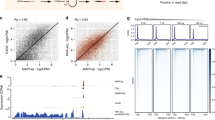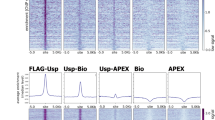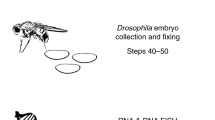Abstract
This protocol describes a method to detect in vivo associations between proteins and DNA in developing Drosophila embryos. It combines formaldehyde crosslinking and immunoprecipitation of protein-bound sequences with genome-wide analysis using microarrays. After crosslinking, nuclei are enriched using differential centrifugation and the chromatin is sheared by sonication. Antibodies specifically recognizing wild-type protein or, alternatively, a genetically encoded epitope tag are used to enrich for specifically bound DNA sequences. After purification and polymerase chain reaction-based amplification, the samples are fluorescently labeled and hybridized to genomic tiling microarrays. This protocol has been successfully used to study different tissue-specific transcription factors, and is generally applicable to in vivo analysis of any DNA-binding proteins in Drosophila embryos. The full protocol, including the collection of embryos and the collection of raw microarray data, can be completed within 10 days.
This is a preview of subscription content, access via your institution
Access options
Subscribe to this journal
Receive 12 print issues and online access
$259.00 per year
only $21.58 per issue
Buy this article
- Purchase on Springer Link
- Instant access to full article PDF
Prices may be subject to local taxes which are calculated during checkout






Similar content being viewed by others
References
Galas, D.J. & Schmitz, A. DNAse footprinting: a simple method for the detection of protein–DNA binding specificity. Nucleic Acids Res. 5, 3157–3170 (1978).
Fried, M. & Crothers, D.M. Equilibria and kinetics of lac repressor–operator interactions by polyacrylamide gel electrophoresis. Nucleic Acids Res. 9, 6505–6525 (1981).
Strutt, H. & Paro, R. Mapping DNA target sites of chromatin proteins in vivo by formaldehyde crosslinking. Methods Mol. Biol. 119, 455–467 (1999).
Toth, J. & Biggin, M.D. The specificity of protein–DNA crosslinking by formaldehyde: in vitro and in Drosophila embryos. Nucleic Acids Res. 28, e4 (2000).
Orlando, V. & Paro, R. Mapping Polycomb-repressed domains in the bithorax complex using in vivo formaldehyde cross-linked chromatin. Cell 75, 1187–1198 (1993).
Walter, J. & Biggin, M.D. Measurement of in vivo DNA binding by sequence-specific transcription factors using UV cross-linking. Methods 11, 215–224 (1997).
Solano, P.J. et al. Genome-wide identification of in vivo Drosophila Engrailed-binding DNA fragments and related target genes. Development 130, 1243–1254 (2003).
Southern, E.M. Detection of specific sequences among DNA fragments separated by gel electrophoresis. J. Mol. Biol. 98, 503–517 (1975).
Dorak, M. Real Time PCR (Taylor & Francis, Oxford, 2006).
Lee, T.I. et al. Control of developmental regulators by Polycomb in human embryonic stem cells. Cell 125, 301–313 (2006).
Boyer, L.A. et al. Core transcriptional regulatory circuitry in human embryonic stem cells. Cell 122, 947–956 (2005).
Kim, T.H. et al. A high-resolution map of active promoters in the human genome. Nature 436, 876–880 (2005).
Robert, F. et al. Global position and recruitment of HATs and HDACs in the yeast genome. Mol. Cell 16, 199–209 (2004).
Alekseyenko, A.A., Larschan, E., Lai, W.R., Park, P.J. & Kuroda, M.I. High-resolution ChIP-chip analysis reveals that the Drosophila MSL complex selectively identifies active genes on the male X chromosome. Genes Dev. 20, 848–857 (2006).
Gilfillan, G.D. et al. Chromosome-wide gene-specific targeting of the Drosophila dosage compensation complex. Genes Dev. 20, 858–870 (2006).
Legube, G., McWeeney, S.K., Lercher, M.J. & Akhtar, A. X-chromosome-wide profiling of MSL-1 distribution and dosage compensation in Drosophila. Genes Dev. 20, 871–883 (2006).
Birch-Machin, I. et al. Genomic analysis of heat-shock factor targets in Drosophila. Genome Biol. 6, R63 (2005).
Sandmann, T. et al. A temporal map of transcription factor activity: mef2 directly regulates target genes at all stages of muscle development. Dev. Cell 10, 797–807 (2006).
Schwartz, Y.B. et al. Genome-wide analysis of Polycomb targets in Drosophila melanogaster. Nat. Genet. 38, 700–705 (2006).
Wei, C.L. et al. A global map of p53 transcription-factor binding sites in the human genome. Cell 124, 207–219 (2006).
Greil, F., Moorman, C. & van Steensel, B. [16] DamID: mapping of in vivo protein–genome interactions using tethered DNA adenine methyltransferase. Methods Enzymol. 410, 342–359 (2006).
Moorman, C. et al. Hotspots of transcription factor colocalization in the genome of Drosophila melanogaster. Proc. Natl. Acad. Sci. USA 103, 12027–12032 (2006).
Bulyk, M.L. DNA microarray technologies for measuring protein–DNA interactions. Curr. Opin. Biotechnol. 17, 422–430 (2006).
Orian, A. Chromatin profiling, DamID and the emerging landscape of gene expression. Curr. Opin. Genet. Dev. 16, 157 (2006).
Buck, M.J. & Lieb, J.D. ChIP-chip: considerations for the design, analysis, and application of genome-wide chromatin immunoprecipitation experiments. Genomics 83, 349–360 (2004).
Lee, T.I., Johnstone, S.E. & Young, R.A. Chromatin immunoprecipitation and microarray-based analysis of protein location. Nat. Protocols 1, 729 (2006).
Hanlon, S.E. & Lieb, J.D. Progress and challenges in profiling the dynamics of chromatin and transcription factor binding with DNA microarrays. Curr. Opin. Genet. Dev. 14, 697–705 (2004).
Simon, R., Radmacher, M.D. & Dobbin, K. Design of studies using DNA microarrays. Genet. Epidemiol. 23, 21–36 (2002).
Dobbin, K., Shih, J.H. & Simon, R. Statistical design of reverse dye microarrays. Bioinformatics 19, 803–810 (2003).
Quackenbush, J. Microarray data normalization and transformation. Nat. Genet. 32 (suppl.): 496–501 (2002).
Breitling, R., Armengaud, P., Amtmann, A. & Herzyk, P. Rank products: a simple, yet powerful, new method to detect differentially regulated genes in replicated microarray experiments. FEBS Lett. 573, 83–92 (2004).
Buck, M.J., Nobel, A.B. & Lieb, J.D. ChIPOTle: a user-friendly tool for the analysis of ChIP-chip data. Genome Biol. 6, R97 (2005).
Gibbons, F.D., Proft, M., Struhl, K. & Roth, F.P. Chipper: discovering transcription-factor targets from chromatin immunoprecipitation microarrays using variance stabilization. Genome Biol. 6, R96 (2005).
Ji, H. & Wong, W.H. TileMap create chromosomal map of tiling array hybridizations. Bioinformatics 21, 3629–3636 (2005).
Gentleman, R.C. et al. Bioconductor: open software development for computational biology and bioinformatics. Genome Biol. 5, R80 (2004).
Saeed, A.I. et al. TM4: a free, open-source system for microarray data management and analysis. Biotechniques 34, 374–378 (2003).
Sullivan, M., Ashburner, R. & Hawley, S. Drosophila Protocols (Cold Spring Harbor Laboratory Press, Cold Spring Harbor, NY, 2000).
Strutt, H., Cavalli, G. & Paro, R. Co-localization of Polycomb protein and GAGA factor on regulatory elements responsible for the maintenance of homeotic gene expression. EMBO J. 16, 3621–3632 (1997).
Campos-Ortega, J.A. & Hartenstein, V. The Embryonic Development of Drosophila melanogaster (Springer, Berlin, Heidelberg, 1985).
Liu, C.L., Schreiber, S.L. & Bernstein, B.E. Development and validation of a T7 based linear amplification for genomic DNA. BMC Genomics 4, 19 (2003).
Karolchik, D. et al. The UCSC Genome Browser Database. Nucleic Acids Res. 31, 51–54 (2003).
Ryder, E., Jackson, R., Ferguson-Smith, A. & Russell, S. MAMMOT—a set of tools for the design, management and visualization of genomic tiling arrays. Bioinformatics 22, 883–884 (2006).
Kelly, K.K., Meadows, S.M. & Cripps, R.M. Drosophila MEF2 is a direct regulator of Actin57B transcription in cardiac, skeletal, and visceral muscle lineages. Mech. Dev. 110, 39–50 (2002).
Acknowledgements
We are grateful to the laboratories of Robert White, Steve Russell (Cambridge) and Renato Paro (Basel) for sharing their ChIP (on chip) protocols with us.
Author information
Authors and Affiliations
Corresponding author
Ethics declarations
Competing interests
The authors declare no competing financial interests.
Rights and permissions
About this article
Cite this article
Sandmann, T., Jakobsen, J. & Furlong, E. ChIP-on-chip protocol for genome-wide analysis of transcription factor binding in Drosophila melanogaster embryos. Nat Protoc 1, 2839–2855 (2006). https://doi.org/10.1038/nprot.2006.383
Published:
Issue Date:
DOI: https://doi.org/10.1038/nprot.2006.383
This article is cited by
-
Specificity of the Hox member Deformed is determined by transcription factor levels and binding site affinities
Nature Communications (2022)
-
Transcription factor paralogs orchestrate alternative gene regulatory networks by context-dependent cooperation with multiple cofactors
Nature Communications (2022)
-
An optimised chromatin immunoprecipitation (ChIP) method for starchy leaves of Nicotiana benthamiana to study histone modifications of an allotetraploid plant
Molecular Biology Reports (2020)
-
The cis-regulatory dynamics of embryonic development at single-cell resolution
Nature (2018)
-
Single vector non-leaky gene expression system for Drosophila melanogaster
Scientific Reports (2017)
Comments
By submitting a comment you agree to abide by our Terms and Community Guidelines. If you find something abusive or that does not comply with our terms or guidelines please flag it as inappropriate.



